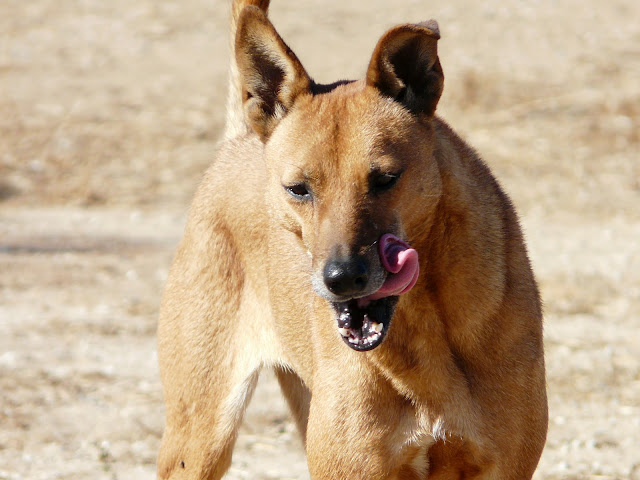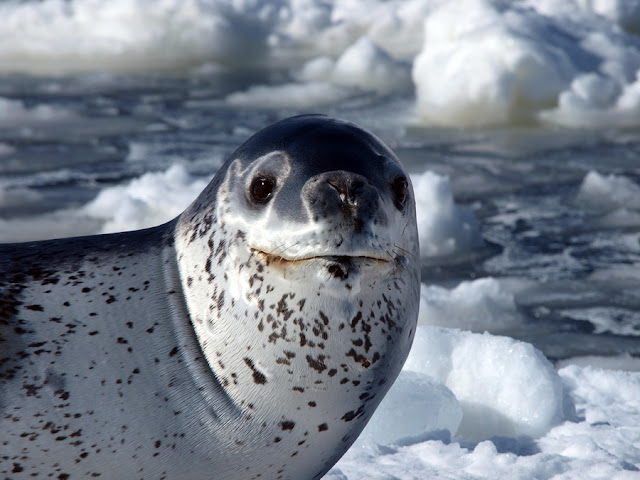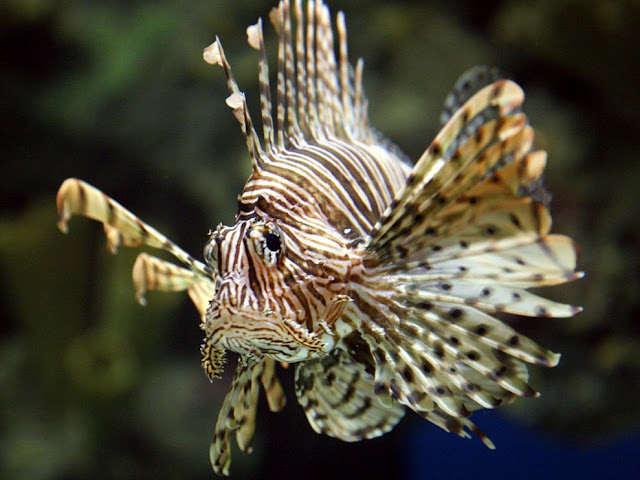The Life of Animals | Dingo | Internal and pariah dogs in South Asia share so many characteristics with the Australian dingo, that experts now believe that, if not a "dingo" in the Australian sense of the word (which implies an independent, wildlife, integrated into the ecosystem ), members of the Canis lupus dingo taxon, in particular of the species Canis under lupus. In comparison with other similar size dogs Familiaris, dingoes have a longer snout, larger carnassials, longer canines and flat skull with large occipital bone line. Dingoes in the north and northwest of Australia than in Central and South Australian population. The Australian dingo has consistently heavier than the Asian.
Fur adult dingoes short, thick at the tail, and varies in thickness and length, depending on the climate. All other colors and color patterns on adult dingoes are regarded as evidence of interbreeding with other domestic dogs. Like all domestic dogs, dingoes tend to phonetic context, with the difference that they whine more and less than domestic dogs bark howl. It is often wrongly claimed that dingoes do not bark. Compared with most other domestic dogs, dingoes barking short and monosyllabic.
During the observations, the barking of the Australian dingo shown that relatively little variability, and sub-characteristics of domesticated dogs bark can not be found. In addition, only 5% of the observed noise from barking. The Australian dingo bark swooshing sound alone or a mixture of atonal / tonal. Moreover, the barking almost exclusively for the notification. Besides dingoes produce a kind of "crying" sound, usually they use when approaching a well, probably to prevent the Dingo is already present. In accordance with current knowledge it is not possible for an Australian dingo barking often obtain them in contact with other domestic dogs. Regardless of whether dingo bark howl bark less frequently, in general, it is not clear.
Dingoes are three basic forms of the first (moan, cry and bark snuffs) not less than 10 options. The frequency of crying varies by season and time of day, and also depends on the breeding, migration, lactation, social stability, and diffusion behavior. Moreover, the curve frequently during periods of food scarcity, because dogs are broader in their environment. It may happen that a dog starts to cry, and some or all of the other dogs howl and bark back from time to time. In the desert, dingoes cry over long distances to other members of the herd to move to other dogs to find, and intruders at bay. Dingoes howl in chorus with significant resin and the increasing number of pack-member increases the variability of the resin and therefore it is assumed that dingoes can reduce the size of the package to be measured without visual contact.
At the time of observation in Germany, dingoes heard sound that observers called Deleted. It Men's scent mark more often than women, especially during the mating season. Unlike wolves, dingoes respond to social cues and gestures of people. In general, the dingoes are shy humans. Although dingoes are generally considered alone (especially in areas where they control), the majority belong to a social group whose members are found from time to time and time together during the breeding season to breed and raise puppies. Dingo, as a rule, very social animals, and the form, where possible, stable packages with clearly defined areas, which rarely coincide with the territory of neighboring packs.
Apparently, specializing in large scale casualties strengthened social behavior and the formation of large groups. Overawing agonist and occurs only in a reduced state between the Australian dingo. Serious fights can only rarely and in extreme conditions are observed. Dogs of a higher rank to show this behavior from time to time to confirm their status, while the lower grades, are more prone to conflict-preventive behavior to show. Big packages are often divided into subgroups a flexible size. In The desert areas are smaller groups of dingoes with a free territorial behavior and the sharing of water resources. On Fraser Island, Dingo was a package the size of two to nine dogs with overlapping areas. But they are very high infanticide, probably because of the high populated dingoes on the island compared to the size of the island and the prey population.
Wild dogs rarely go beyond their territory. When the territory of neighboring parcels overlap, packets tend to avoid contact. The size of habitat and dogs depends largely on the availability of prey. Around the human-controlled areas, as a rule smaller and contain a relatively large number of dingo due to its better access to food. Research in Queensland, the local wild dogs in urban areas have a smaller territory but sometimes two or three square kilometers. Most dingoes remain near their place of birth and Do not drive over 20 miles per day, but some, especially young men to disperse. The size of the individual home range increases with age. During his studies at the dingo from the Eastern Highlands and Central Australia in captivity do not reproduce the cycle was not observed.
Breeding only the heat is controlled by women. Unlike captive dingo, dingo captured men from Central Australia to provide evidence of the male breeding cycle show. Those dingoes showed no interest in women in heat (this time a domesticated dog) outside the breeding season (January to July) and not breeding them. Couple Time usually takes place in Australia in the period from March to May (from other sources in the period from April to June). The exact start of breeding varies depending on age, social status, geographic range and seasonal conditions. Among the dingoes in captivity, pre-estrus in the last 10-12 days. In general only a dingo in a package that successfully breed the alpha pair, and the other members of the pack to help raise puppies. Subordinate actively discourage breeding by the alpha pair, and a number of subordinate females have a false pregnancy. Low number or solitary dingoes can successfully reproduce the structure and packaging falls apart. Puppies subordinates women usually kill the alpha female, which leads to an increase in population will be low, even in good times. In Australia, the teeth mostly underground. Young dingoes usually become independent at the age of three to six months, or to distribute at the age of 10 months, when the next breeding season begins Today, dingoes live in various habitats, including snowcapped mountain forests of eastern Australia, the deserts of central Australia and northern Australia tropical swamp forests. The absence of dingoes in many Australian pastures, probably because of human persecution.
Based on the skull features, size, coat color, and breeding cycles of various regional populations may exist between Australia and Asia, but not in Australia. Today the population of wild dogs on the Australian continent, but a dingo, a wide range of wild domestic dogs (mostly mixed breeds dingo and hybrids), with a huge variety of colors. The increased availability of water, native and introduced prey animals and humans, provided food, the number of wild dogs. Reports from some parts of the state of Australia, wild dogs hunt in packs now, although they are hunted by a single earlier. Dingo densities were measured at speeds up to 0.3 square kilometers in both Guy Fawkes River area of New South Wales and South Australia at the height of the rabbit plague. "Pure" dingoes are widely distributed in North, Northwest, Central, and Australia, rare in the south and northeast of Australia, and possibly extinct in the southeast and southwest regions. This affects primarily the greater part of southern Queensland, New South Wales, Victoria and South Australia. This situation is the construction of a fence dingoes. Although dingoes have been destroyed in most areas south of the Dingo Fence, they still exist in an area of about 58,000 km2 in the dry northern areas north of the dingo fence and so on about 60% of the total area.
Find The Life of Animals





















































